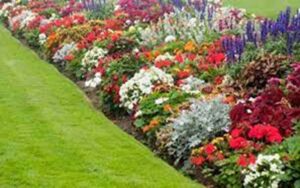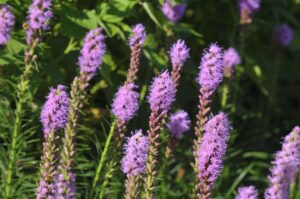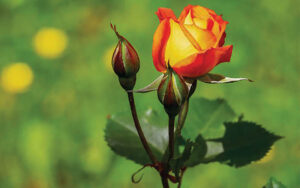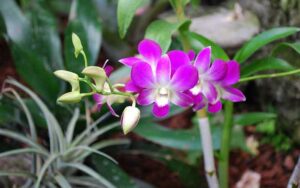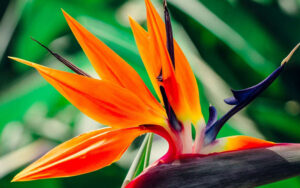Gypsophila, commonly called as ’Baby’s Breath’, is highly valued as a cut flower in floristry to add as a filler in floral decorations. They are tender annuals, hardy perennial or alpine plants that are grown for their beautiful sprays of tiny, button-like blooms in summer, in shades of white or pale pink.
Gypsophilas are a member of the carnation family, Caryophyllaceae. Gypsophila flowers are much preferred by florists because they combine well with any other flower forms. They are major attractions in bridal bouquets. They do exactly the same in a border, where their thin, wiry stems and clouds of flowers make them an excellent ‘filler’, bridging the gap between different plants and bringing an airy feel. They are ideal for cottage gardens, white gardens, gravel gardens and, of course, cutting gardens – all they need is plenty of sunshine and room to spread. Around five stems are perfect for a good display in a bouquet or vase and the blooms should last at least seven days in water. The flowers dry very easily for arrangements, too.
Alpine and miniature forms of gypsophila are low growing, and useful for rockeries, alpine troughs and for edging borders.
CLIMATE
Gypsophila grows well from temperate / cool to little warm and less humid / dry climate. Under North Indian conditions can be cultivated under open sun during winter. Now a day farmers prefer to cultivate under protected structures.
TEMPERATURE
Gypsophila is a sturdy crop and can perform very well in the range of 180C and 350C.
PHOTOPERIOD
Gypsophila is a long day plant, its day length requirement is between 12 to 18 hours. Open field conditions, with warm temperature, promote good flowering.
SOIL
Gypsophila is adapted to a wide range of soils. Soil pH should be between 5.5 to 6.5 or it should be maintained within this range to get maximum efficiency in absorption of nutrients. The salinity level of soil should not be more than 1mS/cm. Hence, as soon as site for cultivation has been selected, the soil should be analyzed to decide on the further reclamation. The soil should be highly porous and well-drained to have better growth and penetration of roots.
BED PREPARATION
Dimensions: Two Row System – Bed width 1m., Height 30cm, and pathway 50 cm.
PLANTING
Planting Season: To protect the plants from rains and hot period, it is advisable to do the plantation at the end of the rainy season, if in an open field. In greenhouse, the plantation can be done year round
• Row to row distance : 50cm
• Plant to plant distance: 20 cm
• Plant population : 24,000 plants per acre
(Planting Density – 10 plants per net. Sq.mtr.)
IRRIGATION
Initially the field should be irrigated by using showering can or shower, twice a day for 1 week after planting. Start drip irrigation from the second week onwards. Use 3 laterals per bed with 1.2 lph or 1.5 lph discharge and dripper to dripper distance of 20 cm.
MULCHING
In an open field, mulching can be done with paddy straw at the time of planting. Advantages of mulching include : Soil moisture conservation, saving irrigation water, preventing weed growth.
SUPPORT
For successful cultivation of Gypsophila, support netting is essential as it helps to obtain erect shoots. If the crop is not supported well enough, it will collapse. This will result in bent stems and cause a stagnation of the crop development. Support netting should be fixed within 3 weeks of planting and before pinching. Netting should be of 20X20 cm at 30 cm height.
PINCHING
Pinching is an essential operation in Gypsophila, as it helps in breaking the apical dominance, thereby enhancing emergence and elongation of the lateral (side) branches. Usually it is done 4 to 5 weeks after planting, depending on the plant growth. This criteria is decided as per the plant growth. Around 5 to 7 highly compact nodes are left from the base and pinching is done at the 8th node.

FERTIGATION
Basal dose : The basal fertilizer dose should be mixed well in the upper 6” of the soil layer. Apply water and maintain ‘vapsa’ (field capacity) condition. Check EC and pH of soil before plantation. The EC of soil should be less than 1Ms/cm, if it is not, leach the soil with plain water, then again check the soil for EC and pH. Basal dose for 10 sq.m. area : Di- Ammonium Phosphate 2kg + Magnesium Sulphate 500g + Biozyme Granules 200g + Humiguard 200g
Vegetative Stage: 19:19:19 + Fertilon combi every alternate day. Maintaining the fertigation EC of around 1.5 to 2 mS/cm, produces strong and sturdy roots. CaNO3 twice a week.
Generative Stage: From the 7th week of planting 16:08:24 + Fertilon combi. CaNO3 twice a week. The fertigation should be done with EC of around 2 – 2.5 mS/cm. After every flush, repeat the addition of basal dose.
GA3 APPLICATION
150 ppm GA3 application is done after shoots attain a height of 3 to 4 cms. If required, a week after the first application, a selective spray with 100 ppm GA3 should be given.
HARVESTING
Harvest Index: When 15 to 20% of flowers open in the inflorescence, the shoots are harvested, leaving 12 to 15 cm from the base. One breathing shoot should be retained on the plant after harvest.
Post-Harvest Solution: Using post-harvest solution is vital in providing optimum performance of the harvested flowers, good opening and long vase life.
The solution includes:
- Sliver Thiosulphate : Ethylene inhibitor – 0.15% (4.5 ml in 3 litres)
- Crysal : 0.2% (6ml in 3 litre)
- White Sugar : 5% to 7% (150g in 3 litres)
PRUNING
Pruning is to be performed after each flush of flowers to lower the plant height. It is performed to encourage the emergence of strong new shoots right from the plant base. It should be preferably done in the morning. Before pruning, irrigation should be reduced considerably to leave the soil moist, but not wet. In outdoor cultivation, under wet climate, it is recommended to prune high after making sure there are new shoots. Spray Benlate @ 2g/l as a drench or spray immediately within the hour of pruning to reduce the possibility of fungal infection.















